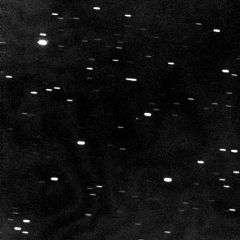Boulder-sized Asteroid Will Burn Up in Earth's Atmosphere Tonight

(PhysOrg.com) -- A tiny asteroid discovered just hours ago at an Arizona observatory will enter Earth's atmosphere harmlessly at approximately 10:46 p.m. Eastern time tonight (2:46 a.m. Greenwich Mean Time). There is no danger to people or property since the asteroid will not reach the ground. It is between 3 and 15 feet (1-5 m) in diameter and will burn up in the upper atmosphere, well above aircraft heights. A brilliant fireball will be visible as a result.
"We want to stress that this object is not a threat," said Dr. Timothy Spahr, director of the International Astronomical Union's Minor Planet Center.
"We're excited since this is the first time we have issued a prediction that an object will enter Earth's atmosphere," Spahr added. Odds are between 99.8 and 100 percent that the object will encounter Earth, according to calculations provided by Andrea Milani of the University of Pisa.
When a meteoroid (small asteroid) enters the atmosphere, it compresses the air in front of it. That compression heats the air, which in turn heats the object, causing it to glow and vaporize. Once it starts to glow, the object is called a meteor.
"A typical meteor comes from an object the size of a grain of sand," explained Gareth Williams of the Minor Planet Center. "This meteor will be a real humdinger in comparison!"
The meteor is expected to be visible from eastern Africa as an extremely bright fireball traveling rapidly across the sky from west to east. The object is expected to enter the atmosphere over northern Sudan at a shallow angle.
"We're eager for observations from astronomers near the asteroid's approach path. We really hope that someone will manage to photograph it," said Williams.
The Minor Planet Center, which is located at the Harvard-Smithsonian Center for Astrophysics, serves as the worldwide clearinghouse for asteroid and comet observations. It collects, checks and disseminates observations and calculates orbits.
Provided by Harvard-Smithsonian Center for Astrophysics





















